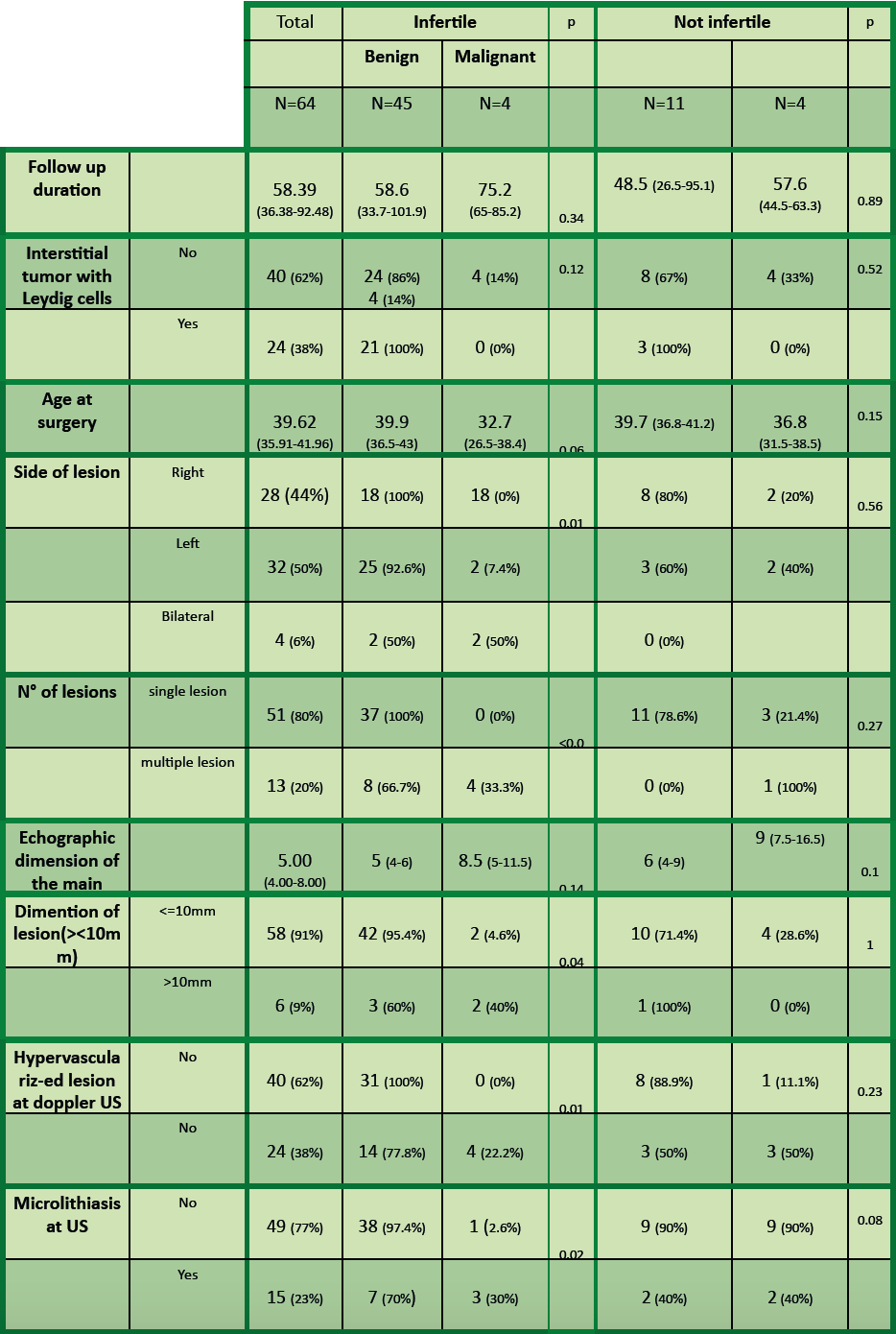Back
Poster, Podium & Video Sessions
Moderated Poster
MP34: Infertility: Therapy
MP34-01: Is testis sparing surgery a safe approach in patients with small testicular lesions referring to a Fertility Center? A retrospective analysis reporting long-term oncological outcomes and factors associated with malignancy
Saturday, May 14, 2022
4:30 PM – 5:45 PM
Location: Room 225
Andrea Gobbo*, Vittorio Fasulo, Cesare Saitta, Pietro Diana, Paola Arena, Giuseppe Chiarelli, Roberto Contieri, Nicola Frego, Davide Maffei, Alberto Saita, Paolo Casale, Giorgio Guazzoni, Massimo Lazzeri, Pier Paolo Avolio, Giovanni Lughezzani, Rodolfo Hurle, Nicolò Maria Buffi, Renzo Benaglia, Paolo Levi, Luciano Negri, Milano, Italy
- AG
Poster Presenter(s)
Introduction: Noninvasive diagnosis of benign testicular lesions eligible for TSS is a challenging topic related to a high risk of misdiagnosis and overtreatment. The aim of the study is to demonstrate the safety of TSS in patients referring to a Fertility Center with an incidental finding of suspicious testicular lesion at ultrasound (US), and to investigate the factors associated with the presence of a malignant tumor.
Methods: We performed a retrospective analysis of a single institutional database including patients treated with TSS between 2002 and 2020. All patients that underwent TSS as a first line surgical approach for incidental US detected lesion found during fertility evaluation were included. The indication of TSS was given if TM were negative and either if lesion dimension were greater than 5mm or if a concomitant TESE was indicated for sperm retrieval. Contingency tables stratified by presence of infertility or malignancy were built to describe the main population characteristics.
Results: Of the 64 patients enrolled 49 proved to be infertile (I), while 15 were not infertile (NI) based on semen analysis and clinical evaluation. 8 patients had malignant lesion at definitive histology; all of them underwent radical orchiectomy either in the same session or subsequently. Median follow up (FU) was 59 months (36-92), and no recurrences were detected. Median lesion dimension was 5mm (4-8). There was a significant difference in the prevalence of malignant lesions between the I and NI groups (p=0.05). Age at surgery was lower in the I group for the malignant lesions (p=0.06). Patients with left sided and bilateral lesions (p=0.01), multifocal lesions (p < 0.01), hypervascularized lesion at doppler US (p=0.01), testicle microlithiasis (p=0.02) and lesions greater than 1cm (p=0.05) had a significant higher prevalence of malignant tumors in the I group, but not in the NI group.
Conclusions: Our data support the safety of a TSS for lesions smaller than 1cm, showing no recurrences for malignant lesions and no new lesions development for benign lesions at long term FU. We highlight the importance of a global clinical evaluation for treatment planning including not only tumor size, but also ultrasonographic features and multifocality.
Source of Funding: None.

Methods: We performed a retrospective analysis of a single institutional database including patients treated with TSS between 2002 and 2020. All patients that underwent TSS as a first line surgical approach for incidental US detected lesion found during fertility evaluation were included. The indication of TSS was given if TM were negative and either if lesion dimension were greater than 5mm or if a concomitant TESE was indicated for sperm retrieval. Contingency tables stratified by presence of infertility or malignancy were built to describe the main population characteristics.
Results: Of the 64 patients enrolled 49 proved to be infertile (I), while 15 were not infertile (NI) based on semen analysis and clinical evaluation. 8 patients had malignant lesion at definitive histology; all of them underwent radical orchiectomy either in the same session or subsequently. Median follow up (FU) was 59 months (36-92), and no recurrences were detected. Median lesion dimension was 5mm (4-8). There was a significant difference in the prevalence of malignant lesions between the I and NI groups (p=0.05). Age at surgery was lower in the I group for the malignant lesions (p=0.06). Patients with left sided and bilateral lesions (p=0.01), multifocal lesions (p < 0.01), hypervascularized lesion at doppler US (p=0.01), testicle microlithiasis (p=0.02) and lesions greater than 1cm (p=0.05) had a significant higher prevalence of malignant tumors in the I group, but not in the NI group.
Conclusions: Our data support the safety of a TSS for lesions smaller than 1cm, showing no recurrences for malignant lesions and no new lesions development for benign lesions at long term FU. We highlight the importance of a global clinical evaluation for treatment planning including not only tumor size, but also ultrasonographic features and multifocality.
Source of Funding: None.


.jpg)
.jpg)